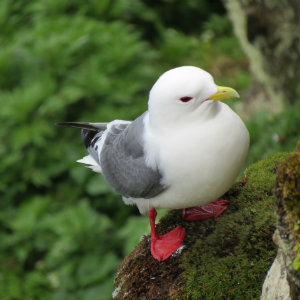RED-LEGGED KITTIWAKE

Rachael Orben
Latin name: Rissa brevirostris
Red-legged kittiwakes are endemic to the Bering Sea. In the 1980s populations of this seabird declined, prompting the IUCN to list the species as 'Vulnerable'. Reasons for the decline are unknown. In 2010, Dr. Rachael Orben began tracking this species during its winter migrations so that its year-round spatial ecology could be considered when assessing factors influencing populations changes. Additionally, she is studying carry-over effects to better link migration behavior to egg laying and reproductive success to the winter migration. This approach will help to understand the trade-offs individuals might make during suboptimal environmental conditions.
Did you know? The majority (~70%) of red-legged kittiwakes nest on the tall sea cliffs of St. George Island. They specialize on foraging for myctophid fishes and squids in the waters to the southwest of the island. They are smaller than black-legged kittiwakes with larger eyes, shorter legs, shorter bills, and red legs. Red-legged kittiwakes winter in the Bering Sea and western North Pacific. They sound like squeaky toys.
Publications:
Lance, B.K. & Roby, D.D. (1998) Diet and postnatal growth in Red-legged and Black-legged Kittiwakes: An interspecies comparison. Colonial Waterbirds, 21, 375–387. Lance, B.K. & Roby, D.D. (2000) DIET AND POSTNATAL GROWTH IN RED-LEGGED AND BLACK-LEGGED KITTIWAKES: AN INTERSPECIES CROSS-FOSTERING EXPERIMENT. The Auk, 117, 1016–1028. Orben, R.A., Irons, D.B., Paredes, R., Roby, D.D., Phillips, R.A. & Scott A Shaffer. (2015) North or south? Niche separation of endemic red-legged kittiwakes and sympatric black-legged kittiwakes during their non-breeding migrations. Journal of Biogeography, 42, 401–412.
